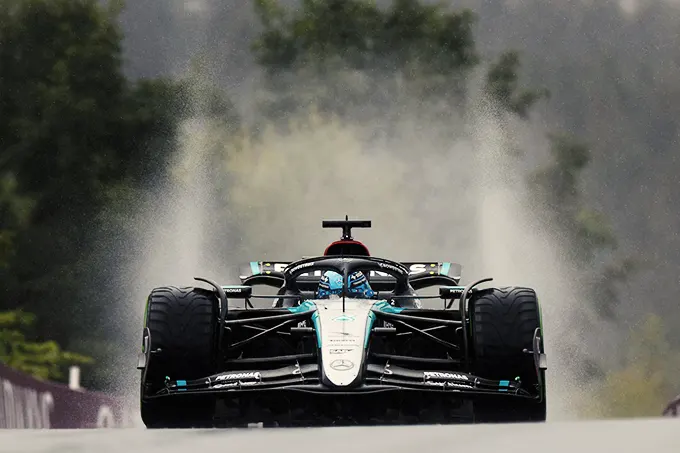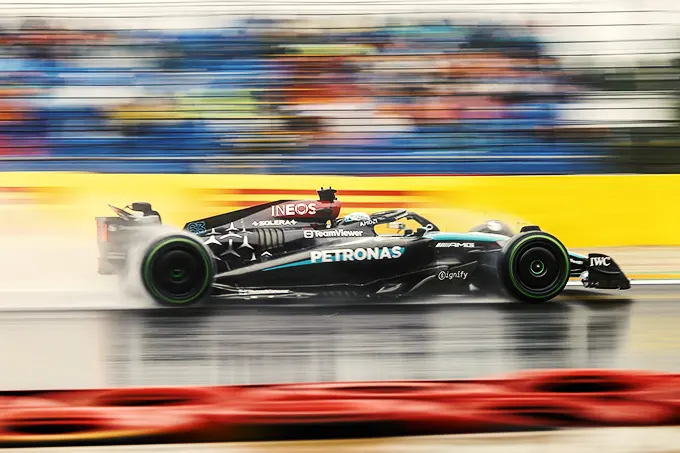Mercedes F1’s resurgence, explained by insider Shovlin, follows strategic car developments.
Three victories in the last four Grand Prix: Mercedes F1’s current streak was almost unthinkable after a sluggish start to the season in Bahrain.
Since introducing the new front wing in Monaco, Mercedes has indeed managed to unlock the potential of its original diva, the W15.
As he assesses the first half of the year, Andrew Shovlin, Chief Race Engineer at Mercedes, naturally highlights the progress made by his team since last March.
“That’s the main thing.”
“In the early races in Bahrain and Jeddah, it was hard to look at the car and understand what needed to be done to make it fast. We could see it had certain strengths, but also numerous weaknesses. Today, the team has brilliantly met this challenge.”
“We know where we want to be in terms of performance. We knew we wanted to win races, and we set ourselves the goal of qualifying in pole position and winning races by the end of the season.”
There was no mystery: it was the developments introduced that allowed the W15 to demonstrate its full potential. Shovlin sums up this development race, currently won by Mercedes F1…
“We didn’t really bring developments to the first races of the year. We focused on understanding the platform we had and ensured we could unlock performance consistently.”
“Once that groundwork was laid, the path forward was clear. So, we started to move things forward with a new floor in Miami.”
“We then developed a front wing that was supposed to come later in the season. We had one on George’s car in Monaco. At that point, you could see that we had a car that was workable and could be improved.”
“What we have seen since then is an impressive number of developments at each circuit. As we solve the car’s handling issues, the challenge becomes simpler and we better understand what we want to do next.”
“At the beginning of the year, we had a car whose behaviour would change radically with relatively small variations in track conditions. In Jeddah, we were bouncing heavily in the high-speed corners. It is quite difficult to untangle all these issues.”
“If you look at circuits like Budapest, you would say that we are still putting too much temperature into the rear tyres and that we need to find a bit more baseline performance. The problems we encounter as the car gets faster are also easier to spot.”
Toto Wolff had promised that Mercedes F1 would bring developments to each race, until the end of the year.
Can Shovlin confirm? Where does the W15 still need to make priority progress?
“The remaining weaknesses in hot conditions are the circuits limited by the rear of the car. We are not as good as the McLarens or Max Verstappen. We saw it in Budapest, and we saw it in Austria. Our gap in race pace in Budapest was smaller, so we have made progress on this point in the recent races. At Silverstone, we were competitive.”
“Everyone is trying to develop their car. If you are not evolving faster than the others, you are regressing. We can only project a month or six weeks ahead, as that is the horizon we work with in the wind tunnel.”
“Will we continue to perform until the end of the year? I hope so. We have good ideas, but there is a lot of work to be done between having an idea and getting physical parts that you can put on the car to make it faster.”
A Mercedes F1 similar to the W15 next year?
2025 also looks promising for Mercedes F1. Indeed, in a period of regulatory stability, the team could continue on its current trajectory next year…
What about the development of the W16? What can Shovlin say on this matter?
“We have not yet made a decision: will the chassis remain the same? Will the gearbox stay the same? The reality is that we probably can’t change everything. We are at a stage where we are trying to assess these components to find the best return on investment within the cost cap framework.”
“However, I think that aerodynamically, our car and those of most people will be an evolution of what we have today. There will be significant changes, but you wouldn’t want to change the architecture of the car and take a major morale hit in the wind tunnel, with a delay you’d then have to recover from. I don’t think many people will do that. That’s why I recently said that the W16 would be a close cousin of the W15.”

- You may also like>Sainz Joins Williams F1, Boosting Sponsorship Hopes
- Following us on>Facebook and>Twitter
Inside Mercedes F1’s Turnaround with Shovlin Inside Mercedes F1’s Turnaround with Shovlin
- Norris rues Saudi crash, eyes lucky break on Sunday
- Sainz Stuns with P6 in Jeddah as Williams Gains Ground
- Bearman Impresses in Jeddah as Ocon Fades in Q1 Exit
- Antonelli Impresses with P5 on the Grid in Jeddah
- Sauber’s Jeddah hopes sink after double Q1 heartbreak
